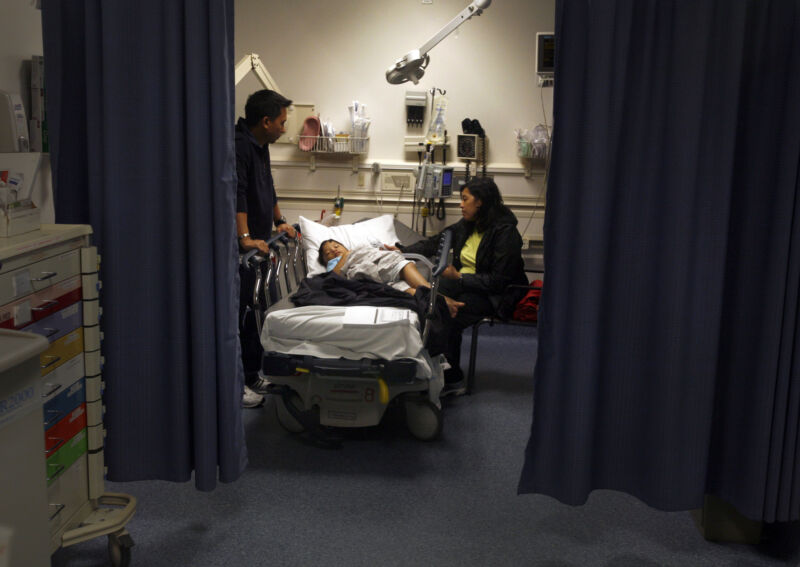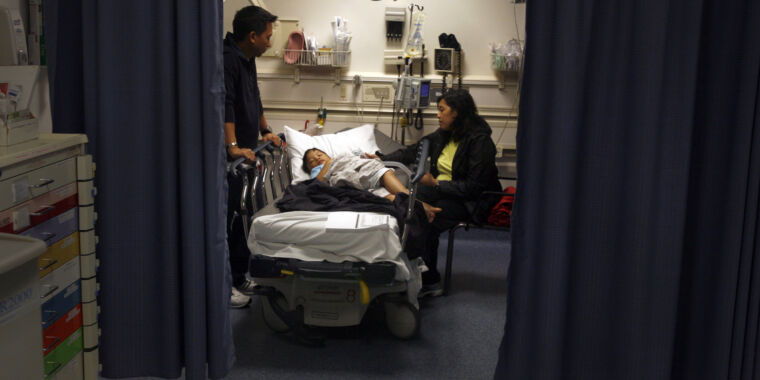
The omicron coronavirus variant caused a spike in cases of a potentially severe breathing condition in babies and toddlers, according to a hospital study recently published in the journal Pediatrics.
The study is small, focusing only on COVID-19-associated cases at one large children’s hospital in Massachusetts during the pandemic. But, it provides some of the initial data on the subject and backs up anecdotes from health care providers that the latest pandemic variant causes more cases of laryngotracheobronchitis—aka croup—in younger children than earlier variants.
Generally, croup is a common upper-respiratory tract condition in which significant inflammation and swelling develop in the larynx and trachea, imperiling breathing. Croup is usually triggered by some type of viral infection, but allergies and other irritants can also be culprits. It can occur at any age but mostly strikes the tiny upper airways of infants and young children, ages 3 months to 5 years.
Croup gets its name from the characteristic “croupy” cough it causes, which is sometimes described as a seal-like barking cough. Other hallmarks of the condition are a harsh, grating sound when a patient breathes in—inspiratory stridor—and respiratory distress.
Before the omicron wave, COVID-19 was associated with croup in some children, but it didn’t appear to be a common outcome of the pandemic infection. That changed during the omicron wave when healthcare providers reported they saw more COVID-19 associated croup cases in young patients.
While data remains sparse on why that might be the case, experts speculate that early variants and the ancestral SARS-CoV-2 tended to target the lower respiratory tract, leading to more severe disease in older age groups. Meanwhile, Omicron seems to have a predilection for the upper-respiratory tract, which may partly explain why it’s both more transmissible and associated with relatively milder illnesses in older age groups.
But, in very young children—who have tiny airways and are still ineligible for COVID-19 vaccination—omicron appears to pose a new risk.
Croup cases
In the new study, researchers, led by pediatrician Ryan Brewster at Boston Children’s Hospital, scanned the hospital’s records for COVID-19 associated croup cases from March 2020 to January 15, 2022. They only found 75 cases—but 61 of the cases (81 percent) occurred during the roughly month-and-a-half time frame of the omicron wave, from December 4, 2021, to January 15, 2022.
Prior to omicron, only 14 COVID-19-associated croup cases appeared from March 2020 to the start of December 2021, usually with no more than one case in a week. Of those cases, 12 went to the emergency department, and two were hospitalized. But at the height of Massachusetts’ omicron surge at the start of 2022, COVID-19-associated croup peaked at around two dozen cases in one week. Of the 61 omicron-period croup cases, 54 went to the emergency department, and seven were hospitalized.
No other COVID-19 peak was linked to a spike in croup cases. And in the cases where doctors tested children for possible coinfections, all the children tested negative, except for one who tested positive for rhinovirus (common cold).
The researchers also noted that the cases of COVID-19-associated croup, largely seen in the omicron period, appeared to skew to more severe croup than what’s seen in cases caused by other viral infections. The COVID-19-associated croup caused more hospitalizations and required more re-dosing of treatments than expected, the researchers report. Four cases required intensive care, though none led to invasive ventilation or death.
For non-COVID-19-associated cases, croup is often considered mild and can sometimes be managed at home with simple treatments and over-the-counter medicines, like acetaminophen (Tylenol). Most importantly, experts recommend bringing a baby or toddler with croup into moist or cold air—a steamy bathroom or outside on a winter night (croup is often worst at night). The cold and moisture help alleviate the inflammation and loosen mucus. But, in cases where a young child is struggling to breathe, a trip to the emergency department can provide quick relief with a steroid, such as the glucocorticoid dexamethasone, to decrease inflammation.
Although the Massachusetts study is limited by its small size and single location, the authors argue that it offers compelling preliminary evidence that omicron infections cause croup, sometimes severe croup, and the topic warrants further research.
“Two years into the COVID-19 pandemic, the pathogenicity, infectivity, and manifestations of new variants of SARS-CoV-2 have been dynamic and unique,” they write. “Croup may represent yet another such novel presentation.”








